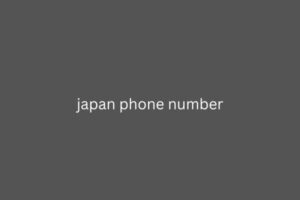Eye-catching images may pique the interest of visitors, which can be beneficial. But do all images look good on mobile device screens? Of course not. Images with fine details (especially small details) or complex graphics, or photos of landscapes, are not a good idea. They will not display as intended on a screen that is only a few inches wide.
It’s also bad practice to upload the same “large” image for all screen sizes. Since many consumers surf the web using mobile data, they may immediately abandon an image page that takes too long to load, which indicates an image size of more than 1 MB.
Choose flexible images and media by applying responsive japan phone number design principles. This way, you’ll maintain the integrity of your content at any resolution and in any situation.
Follow the rules of thumb
Although consumers interact with touchscreens in three different ways, most hold the device with just one hand, and more importantly, they rely on one thumb (usually on the right hand) when using mobile apps, browsing websites, and more.
Ensure the usability of your website by making sure the top-level menu, all necessary controls, and common actions are easily accessible with one hand. Check out the image below to see where you should place these elements.
Keep in mind mobile design principles
Don’t forget that a finger is much bigger than a cursor. On small screens, it’s crucial to leave enough space between clickable elements and buttons. Make sure your touch targets are at least 44x44 pixels (as recommended by Apple). Don’t worry if they’re larger than that: Google recommends that controls be 48x48 pixels in size.

For Android devices, you can use an automated testing tool like Robolectric to automatically detect touch targets that are too small, or if you want to do manual testing, you can use Accessibility Scanner. Create forms that fit mobile device screens and use readable fonts.
Create a prototype and test it
Creating a prototype using a framework like Bootstrap is an important step towards a fully functional and easy-to-use website. With an interactive prototype at your fingertips, you will be able to test it with real users and on a variety of devices.
Test on multiple devices and note how the images look on each display (e.g. retina). Ask your friends and relatives to try the site as well. This type of testing will help you find out if the site needs improvements, e.g. smaller navigation bar, larger buttons, new images, etc.
Using meta tags and CSS
There are some basic HTML tags and media queries that developers can utilize to craft the right design. Here are some of them:
<meta name="viewport" content="width=device-width, initial-scale=1" />
This meta tag will tell the device that the content is optimized for mobile devices and the device width must be set. Some developers also set "user-scalable" to "no" to disable scaling.
Introducing "min-width" / "max-width" media queries to apply specific design styles based on the width of the device.
Steps to mobile-first design and development
1. List the content
Create a spreadsheet with all the elements you want to include in your website. First, it is recommended that you build a spreadsheet that lists all the content items you intend to include in your design. Once you compile this list, you will have a clear idea of everything that needs to be included in your design.
The goal of this phase is to avoid missing any important aspects and verify that your design is complete and covers all relevant content. In addition, having a detailed content list allows you to prioritize and focus your resources on the most important aspects of your design. Overall, taking inventory of your materials is an important stage in the design process that can help you create a well-organized and successful design.
This step also helps you manage the visual hierarchy of your content. You can prioritize the items in your content inventory spreadsheet and decide how to highlight the most important items.